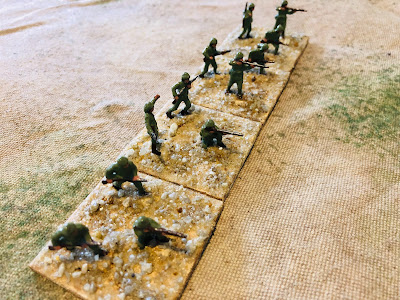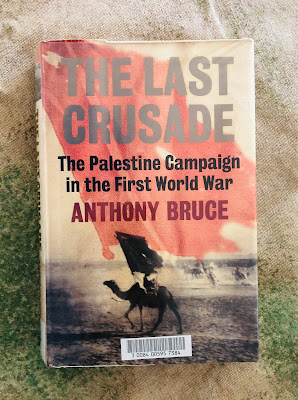Having just held off a determined Blue (French) action on the let flank it was now Red (Austrian) army's turn to assault with their Corps II with flanking support from their Corps III. Blue's reserves are severely depredated with only one cavalry unit available. If Red can win this action they will win the battle campaign by forcing an enemy Corps to retire off the map.
 |
| I do like the odd black and white photograph of Spencer-Smith figures on the tabletop. They remind me of looking through various wargaming books borrowed from the local library when I was young. |
 |
| The battle map with Red (Austrian) Corps II is on the attack. |
The action is transferred to the tabletop and forces deployed. The defenders are always required to deploy first. The action, as with all previous actions, is being fought using One-Hour Wargames Horse and Musket rules as written bar one change to the rules. The change allows for a commander to be attached to one infantry or cavalry unit. A commander's attached unit rolls two dice and selects the highest value for combat (shooting or melee).
 |
| Tabletop layout. |
 |
| Blue (French) as the defenders deploy first. One infantry unit is deployed as skirmishers in the woods. |
 |
| Red (Austrian) deployed second as they are the attaching force. |
The order of battle for this action has both forces understrength with less than 8 units.
Blue (French):
- 2 x infantry units (one deployed as skirmishers)
- 1 x artillery unit
- 1 x cavalry unit
They only have one cavalry unit available off-table and in reserve.
Red (Austrians):
- 2 x infantry units
- 2 x artillery units
- 1 x cavalry unit
They have 5 flanking units which they can bring into the game, a mix of infantry, cavalry and artillery.
(Note - I made a mistake when setting up Red forces who should have had another infantry unit)
On to the game...
 |
| Red (Austrian) commander played a patient game, pushing their cavalry out wide and bombarding any visible Blue (French) units while waiting for their reserves to arrive. Blue (French) where the first force to receive their only reserve unit in the form of cavalry. |
 |
| Red's bombardment prompted Blue to push forward their skirmishers and cavalry in an attempt to silence the guns. Meanwhile hidden by the woods there is a cavalry engagement underway. |
 |
Blue's attack was proving effective. Their cavalry eliminating infantry and their skirmishers shooting from some difficult terrain, but Red reserve cavalry can be seen in the far arriving in support.
|
 |
| The cavalry arrive. |
 |
| More reserves arrive on the flank. |
 |
| Blue's (French) attack is neutralised. |
 |
| A small victory for Blue cavalry who defeated their opponents. Only to have an "Enemy Panic" chance card applied to them and they disappeared. Not that surprising when they can see all the reserves arriving. |
 |
| The game is up with only two units left Blue loose this action and the battle. |
Summary...
Blue as always in a tricky spot, starting this game understrength with few reserves to hang on for 15 turns. They lasted 10 turns before being overwhelmingly outnumbered.
 |
| The battle is lost as Blue Corps III retires off the map. |
The battle campaign is over after 5 enjoyable tabletop actions, but what would I do differently?
1) Running this style of campaign again I would make sure all the lanes on the map would have opposing forces (see here for explanation of map lanes). This would make the allocation of reserves an important decision. Any allocation of reserves would have to be carefully done, as once committed to a corps they cannot be returned. In this battle campaign the unopposed flanking corps essentially became a second reserve.
2) I would start all corps with 6 units, prompting the need for feeding in reserves at the very start.
3) To win an action on the tabletop meant reducing the enemy units to a level where they retired. I will revisit these rules and decide if there is an opportunity to include taking objectives (towns or hills) as another way to win an action, or at the very least sway the result.
4) From a narrative point of view I would have each move count as part of the day. For example, early morning, late morning, midday, early afternoon, late afternoon, eventing. If the battle remains undecided then there would be the option of a second day (both parties willing) and half the lost units would be recovered (rounding up).
As much is I want to begin another one of these battle campaigns, perhaps with an ACW setting, my Ancients campaign has been sidelined for a few weeks and needs attention.

















































